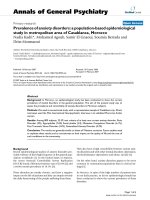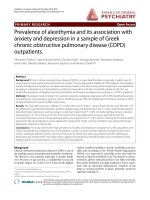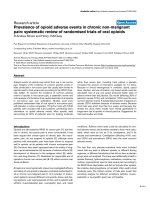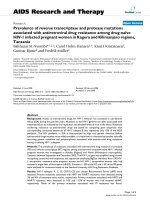Báo cáo y học: " Prevalence of GB virus type C in urban Americans infected with human immunodeficiency virus type 1" ppsx
Bạn đang xem bản rút gọn của tài liệu. Xem và tải ngay bản đầy đủ của tài liệu tại đây (222.72 KB, 5 trang )
BioMed Central
Page 1 of 5
(page number not for citation purposes)
Retrovirology
Open Access
Research
Prevalence of GB virus type C in urban Americans infected with
human immunodeficiency virus type 1
Stephen M Smith*
1,2
, Michael J Donio
1
, Mahender Singh
1
, James P Fallon
1
,
Lavanya Jitendranath
1
, Natalia Chkrebtii
1
, Jihad Slim
1
, Diana Finkel
1
and
George Perez
1
Address:
1
Saint Michael's Medical Center, Newark New Jersey 07102, USA and
2
The New Jersey Medical School, Newark New Jersey 07102, USA
Email: Stephen M Smith* - ; Michael J Donio - ;
Mahender Singh - ; James P Fallon - ;
Lavanya Jitendranath - ; Natalia Chkrebtii - ; Jihad Slim - ;
Diana Finkel - ; George Perez -
* Corresponding author
Abstract
GBV-C virus infection has been linked to improved clinical outcome in HIV-1 co-infected
individuals. The epidemiology of GBV-C has, thus far, been limited to the gay male, HIV
+
population.
Here we describe the prevalence of antibodies against GBV-C envelope glycoprotein E2 and GBV-
C viremia in an HIV
+
inner city population. This study group is predominantly African-American;
41% of the participants are women. The major risk factor for HIV infection is intravenous drug use.
Overall, 56% of the study population had evidence of current or past infection with GBV-C. GBV-
C exposure was not associated with hepatitis C virus infection. The group of participants, who had
GBV-C viremia and anti-E2 antibodies, had high percentage of patients with an undetectable HIV-
1 viral load. These data provide increased insight into the prevalence of GBV-C co-infection in the
HIV epidemic in this understudied population.
Background
In 1995, several groups independently reported the dis-
covery of two new viruses, which were termed GB virus
type C (GBV-C) and hepatitis G virus, respectively (review
in [1]). Subsequently, these viruses were found to be two
strains of a novel RNA virus belonging to the Flaviviridae
family. GBV-C (the designation used in this paper) is dis-
tantly related to hepatitis C virus (HCV) with which it
shares approximately 30% amino acid homology. While
HCV replicates primarily in hepatocytes, GBV-C replicates
in both T- (CD4
+
and CD8
+
) and B-lymphocytes. GBV-C
is not known to cause disease in humans, but can estab-
lish chronic infection in which virus may be present in the
blood. After years of infection, infected individuals may
spontaneously clear GBV-C [1], although the reasons for
this phenomenon are not known. In most cases, clearance
of GBV-C is associated with seroconversion to the viral
envelope glycoprotein, E2. Paradoxically, viremia may
also persist despite the presence of anti-E2 antibodies, and
clearance may occur in the absence of seroconversion.
GBV-C may be transmitted through several routes, includ-
ing sexual contact, exposure to contaminated blood and
vertical transmission. To date, the epidemiology of GBV-
C is incompletely understood.
Published: 31 May 2005
Retrovirology 2005, 2:38 doi:10.1186/1742-4690-2-38
Received: 03 May 2005
Accepted: 31 May 2005
This article is available from: />© 2005 Smith et al; licensee BioMed Central Ltd.
This is an Open Access article distributed under the terms of the Creative Commons Attribution License ( />),
which permits unrestricted use, distribution, and reproduction in any medium, provided the original work is properly cited.
Retrovirology 2005, 2:38 />Page 2 of 5
(page number not for citation purposes)
Of interest, GBV-C infection appears to alter the course of
human immunodeficiency virus type 1 (HIV-1) infection.
Following an initial report in 1998 [2], several studies
have shown that individuals, who are co-infected with
GBV-C and HIV-1, have lower levels of HIV-1 viremia and
higher CD4
+
T cell counts than those infected with HIV-1
alone [3-8]. However, other studies have not supported
this association [9-13]. A recent report failed to find evi-
dence that active GBV-C co-infection improved survival
12 to 18 months after HIV-1 seroconversion [6]. Survival
rates in persons with persistent GBV-C viremia were, how-
ever, significantly better 5 to 6 years after HIV-1 infection.
GBV-C prevalence is known to be significantly higher in
HIV-1 seropositive individuals (>75%) [3,5,6,13] com-
pared with healthy blood donors (10–20%) [14]. In most
cases, this observation is based on evaluation of patient
groups comprised primarily of men, who have sex with
men (MSM). The epidemiology of GBV-C among HIV-1
seropositive, inner city residents, whose risk factors, eth-
nicity and gender are distinct, is not known. In the present
study, we evaluated the prevalence of GBV-C infection in
a population consisting primarily of HIV-infected, urban
African-Americans.
Methods
Study Population
The study population consisted of 353 HIV-1-infected
patients who regularly attended a large urban HIV-1
clinic. The patients were recruited over a 3-month period
between February and April 2004. The study was
approved by the institutional review board of Saint
Michael's Medical Center and informed consent was
obtained from all participants prior to sample collection.
Blood samples were obtained for analysis of GBV-C RNA
and anti-E2 antibodies, and for measurement of HIV-1
plasma RNA levels, CD4
+
T-cell counts and HCV serology.
Treatment was independently determined by the treating
physician.
Laboratory Assays
Studies for HIV RNA levels, HIV antibodies, and HCV
antibodies were performed by commercial laboratories.
RT-PCR for GBV-C RNA
Total RNA was extracted from 100 µl of serum using an
RNAeasy Mini Kit (Qiagen, Valencia, CA). Twenty-five
percent of the isolated RNA was used for reverse transcrip-
tion (RT) and first round PCR. RT-PCR was performed in
a single tube using the AccessQuick RT-PCR System
(Promega, Madison, WI). Both first- and second-round
PCR were carried out using primers that hybridize to 5'
non-translated regions of an infectious GBV-C clone
(GenBank accession no. AF121950, nt 54 to 389). Primers
for the first-round RT-PCR were GBVF1 5'-
CCGACGCCTATCTAAGTA GACGC and GBVR1 5'-
TCAACTCGCCGGATAAACCTATTGG. Primers for the sec-
ond-round PCR were GBVF2 5'-GTGACAGGGTTGG-
TAGG and GBVR2 5'-GACATTGAAGGGCGACGTGG.
PCR products were detected on 1.5% agarose gels contain-
ing 0.5 µg/ml ethidium bromide. The expected band sizes
were 336 and 231 bp for the first- and second-round PCR,
respectively. Known GBV-C positive serum (generously
provided by Dr. J. Stapleton, University of Iowa, Iowa
City, IA) and negative (saline) controls were included in
each assay. Samples yielding ambiguous PCR results were
re-tested using freshly extracted RNA from the original
sera. A reaction was considered positive if either the first-
or second-round PCR produced a band of the expected
size. The assay was validated using in vitro transcribed
GBV-C RNA together with positive and negative control
samples.
Detection of Antibodies against GBV-C glycoprotein E2
Antibodies against GBV-C envelope glycoprotein E2 were
detected using the µPlate anti-HGenv ELISA test (Roche
Diagnostics, Indianapolis, IN) according to the manufac-
turer's protocol, which is summarized below. A 1:20 dilu-
tion of each serum sample was added to an incubation
solution containing HGV-E2 antigen-bound, biotinylated
anti-E2 antibodies. This solution was then added to a
streptavidin-coated microwell plate. After the plate was
washed once with the wash-solution, POD-labeled, anti-
human Fcγ antibodies were added to the plate, followed
by ABTS
®
substrate solution. Absorbance was read at 405
nm. A sample was considered positive if the A
405
≥ the cut-
off value calculated according to the manufacturer's pro-
tocol (0.2 times the sum of the positive and negative con-
trols). Samples falling within +/-15% of the cut-off value
were repeated using freshly diluted sera.
Statistical Analyses
A chi-square or Fisher's exact test was used to analyze cat-
egorical variables. The group means were compared by
either the Student's t-test, Mann-Whitney U test or Wil-
coxon rank sum test. p values <0.05 were considered to
indicate statistical significance and all reported p values
were two-sided.
Results
GBV-C prevalence
Of the 353 subjects studied here, 208 (59%) were men
and 145 (41%) were women. The mean age within the
cohort was 46.4 years, and the mean CD4
+
T-cell count
was 416 cells/mm
3
. Plasma from each patient was tested
for the presence of GBV-C RNA and anti-glycoprotein E2
antibodies. GBV-C RNA was detected in 23.2% (82/353)
of subjects. Among those testing positive for GBV-C RNA,
13 (16%) were also found to be positive for anti-E2 anti-
bodies. Within the study population, 32.3% (114/353)
Retrovirology 2005, 2:38 />Page 3 of 5
(page number not for citation purposes)
tested positive for anti-E2 antibodies alone, while the
remaining subjects (157/353) tested negative for both
GBV-C RNA and anti-E2 antibodies. Overall, 56% of the
study population had evidence of GBV-C exposure,
defined as a positive result for either GBV-C RNA or anti-
E2 antibodies.
Among the study subjects, the main HIV-1 risk factors
were intravenous drug use (IDU) (53.8%) and heterosex-
ual contact with a person who used intravenous drugs
(32.6%) (Table 1). The majority of the enrolled popula-
tion (71.4%) was African-American. There was no signifi-
cant difference in GBV-C status between sex, race or HIV-
1 risk factor (Table 2).
Although GBV-C is thought to be transmitted by similar
routes as HCV, HCV antibody status was not strongly
associated with GBV-C exposure (Table 3). A total of 163
subjects were positive for HCV antibodies. Among those,
61% (99/163) were also positive for either GBV-C viremia
Table 1: HIV-1 risk factors according to GBV-C status.
GBV-C RNA positive Anti- E2 antibody positive
alone
Negative for GBV-C RNA
and Anti-E2 antibody
Total
Hemophilia n (%)* 1 (11%) 2 (22%) 6 (67%) 9 (100%)
Heterosexual 25 (22%) 38 (33%) 52 (45%) 115 (100%)
Heterosexual/IVDU 10 (24%) 10 (24%) 12 (52%) 42 (100%)
IVDU 35 (22%) 58 (37%) 65 (41%) 158 (100%)
MSM 8 (35%) 2 (9%) 13 (66%) 23 (100%)
Transfusion 2 (20%) 3 (30%) 5 (50%) 10 (100%)
Other 1 (17%) 1 (17%) 4 (67%) 6 (100%)
*- percentage by risk factor
Table 2: Demographics of the study population.
GBV-C RNA positive Anti- E2 positive Unexposed to GBV-C All subjects
Total 82 114 157 353
Age* 44.7 ± 7.9 47.0 ± 8.9 46.8 ± 9.5 46.4 ± 9.0
Sex n (%)
Male 52 (63%) 65 (57%) 91 (58%) 208 (59%)
Female 30 (37%) 49 (43%) 66 (42%) 145 (41%)
Race n (%)
Black 65 (79%) 83 (73%) 104 (66%) 252 (71%)
Hispanic 6 (7%) 18 (16%) 31 (20%) 55 (16%)
Caucasian 11 (13%) 13 (11%) 22 (14%) 46 (13%)
* -average ± S.D.
Table 3: The presence of hepatitis C virus antibody according to GBV-C status.
HCV Antibody Status GBV- C RNA positive n (%) Anti-E2 antibody positive n (%) Negative for GBV-C RNA and
Anti-E2 antibody n (%)
HCV (+) 39 (48%) 60 (53%) 64 (41%)
HCV (-) 43 (52%) 54 (47%) 93 (59%)
Total 82 (100%) 114 (100%) 157 (100%)
Retrovirology 2005, 2:38 />Page 4 of 5
(page number not for citation purposes)
or anti-E2 antibody, while 51% (97/190) of the HCV anti-
body negative population had evidence of GBV-C
exposure.
Implications of GBV-C viremia
Although this study represents a cross-sectional analysis,
we evaluated the relationship between GBV-C infection
status and HIV-1 viremia or CD4
+
T cell count. GBV-C
exposure was associated with a larger percentage of
patients with CD4
+
T cell counts >350 cells/mm
3
(p <
0.05, Table 4). In addition, 46.3% of patients with GBV-C
viremia had plasma HIV-1 RNA levels <500 copies/ml,
compared with 36.9% of patients who tested negative for
GBV-C RNA and anti-E2 antibodies. This trend, while sug-
gestive of an effect of GBV-C co-infection on HIV-1, was
not statistically significant. However, a separate analysis
of the 13 patients who tested positive for both GBV-C
RNA and anti-E2 antibodies revealed a significant associ-
ation between GBV-C infection and low plasma HIV-1
RNA levels (p < 0.05, Table 5). Overall, for the entire
cohort, GBV-C status had no effect on the mean plasma
HIV-1 RNA levels or the mean CD4
+
T-cell count.
Conclusion
This report is the first to describe the prevalence of GBV-C
in an inner city population comprised predominantly of
HIV-1-infected African-Americans. Previous studies,
which focused on HIV-seropositive male homosexuals,
found evidence of prior or current GBV-C infection in 74
to 85% of subjects [3,5,6,13]. In contrast, only 56% of the
population studied here tested positive for GBV-C RNA
and/or anti-E2 antibodies. Analysis of HIV-1 risk factors
did not reveal a significant correlation between specific
high-risk behavior for HIV-1 and GBV-C exposure.
Our findings comprise data from the largest such cohort
studied to date. Within our study population, we found a
61% rate of GBV-C exposure among 163 HCV antibody
positive patients; a rate not significantly different from
that of HCV antibody negative patients (51%). Taken
together with published findings, these data suggest that
GBV-C may be transmitted more efficiently by male
homosexual contact than by either intravenous drug use
or heterosexual contact. Alternatively, infection with GBV-
C may have occurred at a higher rate in our population,
but either GBV-C viremia or anti-E2 antibody responses
may have waned over time in some patients. Pre-exposure
to GBV-C may have rendered individuals within the
population immune to secondary infection with this fla-
vivirus. Within this cohort, we also studied a large popu-
lation of HIV-infected women (n = 145) and found a
similar rate of GBV-C exposure (55%) to that found in
men (57%).
Although the effect of GBV-C on HIV-1 infection remains
controversial, most studies have shown higher CD4
+
cell
counts and lower HIV-1 viral loads in GBV-C viremic
patients. Our study suggests a similar effect among a pop-
Table 4: Patient stratification by CD4
+
T-cell count, according GBV-C exposure status.
Exposed to GBV-C n (%) Negative for GBV-C RNA and Anti-E2
antibody n (%)
CD4
+
T-cell count
≤ 350 cells/mm
3
81 (41%) 82 (52%)
>350 cells/mm
3
115 (59%) † 75 (48%)
Total 196 (100%) 157 (100%)
† The percentage (115/196; 59%) of GBV-C exposed subjects with a CD4
+
T-cell count >350 cells/mm
3
was higher than that (75/157; 48%) of those
unexposed to GBV-C (p < 0.05; Chi-square test).
Table 5: Plasma HIV-1 RNA levels according to GBV-C status.
HIV RNA copies/mL GBV-C RNA positive/ anti-
E2 antibody positive n (%)
GBV-C RNA positive n (%) Anti-E2 antibody positive n
(%)
Negative for GBV-C RNA
and Anti-E2 antibody n (%)
≤ 500 10 (77%)
†
28 (41%) 46 (40%) 58 (37%)
>500 3 (23%) 41 (59%) 68 (60%) 99 (63%)
Total 13 (100%) 69 (100%) 114 (100%) 157 (100%)
p < 0.05 when comparing RNA+/E2+ group to other GBV-C status groups.
† Comparison among the four groups were made using the Chi-square test.
Publish with BioMed Central and every
scientist can read your work free of charge
"BioMed Central will be the most significant development for
disseminating the results of biomedical research in our lifetime."
Sir Paul Nurse, Cancer Research UK
Your research papers will be:
available free of charge to the entire biomedical community
peer reviewed and published immediately upon acceptance
cited in PubMed and archived on PubMed Central
yours — you keep the copyright
Submit your manuscript here:
/>BioMedcentral
Retrovirology 2005, 2:38 />Page 5 of 5
(page number not for citation purposes)
ulation with distinct characteristics including ethnicity,
transmission profiles and gender than those previously
reported. In our cohort, 77% of patients who tested posi-
tive for both GBV-C RNA and anti-E2 antibodies had
plasma HIV-1 RNA levels <500 copies/ml. While these
data represent a small number of patients, the percentage
with low HIV-1 viral load was statistically higher among
these patients when compared to those in the other
groups. The co-existence of GBV-C viremia and anti-E2
antibody may be a marker of long-term GBV-C infection,
which has recently been shown to correlate with a better
outcome in HIV-1-infected individuals [6].
Our study was limited in several aspects, including a lack
of longitudinal follow-up. In addition, we were unable to
compile adequate data on the duration of HIV-1 infection
and the possible impact of antiretroviral therapy in these
patients. The latter restriction may be balanced by the fact
that nearly all HIV-infected patients in this large cohort
received antiretroviral therapy under a relatively consist-
ent standard practiced within a single clinical
environment.
Further longitudinal studies will be necessary in HIV-1-
infected patients to clarify the potential effects of GBV-C
co-infection. Our data support the hypothesis that GBV-C
viremic patients with HIV-1 respond better to therapy,
which has been suggested by another study [15]. This pos-
sibility needs to be tested prospectively. Our data also sug-
gest that the behaviors associated with HIV-1
transmission in the inner city are less associated with
GBV-C exposure than in other high-risk settings.
References
1. Stapleton JT, Williams CF, Xiang J: GB virus type C: a beneficial
infection? J Clin Microbiol 2004, 42:3915-3919.
2. Toyoda H, Fukuda Y, Hayakawa T, Takamatsu J, Saito H: Effect of
GB virus C/hepatitis G virus coinfection on the course of HIV
infection in hemophilia patients in Japan. J Acquir Immune Defic
Syndr Hum Retrovirol 1998, 17:209-213.
3. Heringlake S, Ockenga J, Tillmann HL, Trautwein C, Meissner D, Stoll
M, Hunt J, Jou C, Solomon N, Schmidt RE, Manns MP: GB virus C/
hepatitis G virus infection: a favorable prognostic factor in
human immunodeficiency virus-infected patients? J Infect Dis
1998, 177:1723-1726.
4. Lefrere JJ, Roudot-Thoraval F, Morand-Joubert L, Petit JC, Lerable J,
Thauvin M, Mariotti M: Carriage of GB virus C/hepatitis G virus
RNA is associated with a slower immunologic, virologic, and
clinical progression of human immunodeficiency virus dis-
ease in coinfected persons. J Infect Dis 1999, 179:783-789.
5. Tillmann HL, Heiken H, Knapik-Botor A, Heringlake S, Ockenga J,
Wilber JC, Goergen B, Detmer J, McMorrow M, Stoll M, Schmidt RE,
Manns MP: Infection with GB virus C and reduced mortality
among HIV-infected patients. N Engl J Med 2001, 345:715-724.
6. Williams CF, Klinzman D, Yamashita TE, Xiang J, Polgreen PM,
Rinaldo C, Liu C, Phair J, Margolick JB, Zdunek D, Hess G, Stapleton
JT: Persistent GB virus C infection and survival in HIV-
infected men. N Engl J Med 2004, 350:981-990.
7. Xiang J, Wunschmann S, Diekema DJ, Klinzman D, Patrick KD,
George SL, Stapleton JT: Effect of coinfection with GB virus C
on survival among patients with HIV infection. N Engl J Med
2001, 345:707-714.
8. Yeo AE, Matsumoto A, Hisada M, Shih JW, Alter HJ, Goedert JJ:
Effect of hepatitis G virus infection on progression of HIV
infection in patients with hemophilia. Multicenter Hemo-
philia Cohort Study. Ann Intern Med 2000, 132:959-963.
9. Birk M, Lindback S, Lidman C: No influence of GB virus C repli-
cation on the prognosis in a cohort of HIV-1-infected
patients. Aids 2002, 16:2482-2485.
10. Bjorkman P, Flamholc L, Naucler A, Molnegren V, Wallmark E, Widell
A: GB virus C during the natural course of HIV-1 infection:
viremia at diagnosis does not predict mortality. Aids 2004,
18:877-886.
11. Quiros-Roldan E, Maroto MC, Torti C, Moretti F, Casari S, Pan A,
Carosi G: No evidence of benefical effect of GB virus type C
infection on the course of HIV infection. Aids 2002,
16:1430-1431.
12. Sabin CA, Devereux H, Kinson Z, Griffioen A, Brown D, Dusheiko G,
Lee CA: Effect of coinfection with hepatitis G virus on HIV
disease progression in hemophilic men. J Acquir Immune Defic
Syndr Hum Retrovirol 1998, 19:546-548.
13. Van der Bij AK, Kloosterboer N, Prins M, Boeser-Nunnink B, Geskus
RB, Lange JM, Coutinho RA, Schuitemaker H: GB Virus C Coinfec-
tion and HIV-1 Disease Progression: The Amsterdam
Cohort Study. J Infect Dis 2005, 191:678-685.
14. Stapleton JT: GB virus type C/Hepatitis G virus. Semin Liver Dis
2003, 23:137-148.
15. Rodriguez B, Woolley I, Lederman MM, Zdunek D, Hess G, Valdez H:
Effect of GB virus C coinfection on response to antiretroviral
treatment in human immunodeficiency virus-infected
patients. J Infect Dis 2003, 187:504-507.



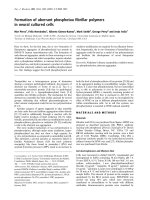

![Báo cáo Y học: Effect of adenosine 5¢-[b,c-imido]triphosphate on myosin head domain movements Saturation transfer EPR measurements without low-power phase setting ppt](https://media.store123doc.com/images/document/14/rc/vd/medium_vdd1395606111.jpg)
